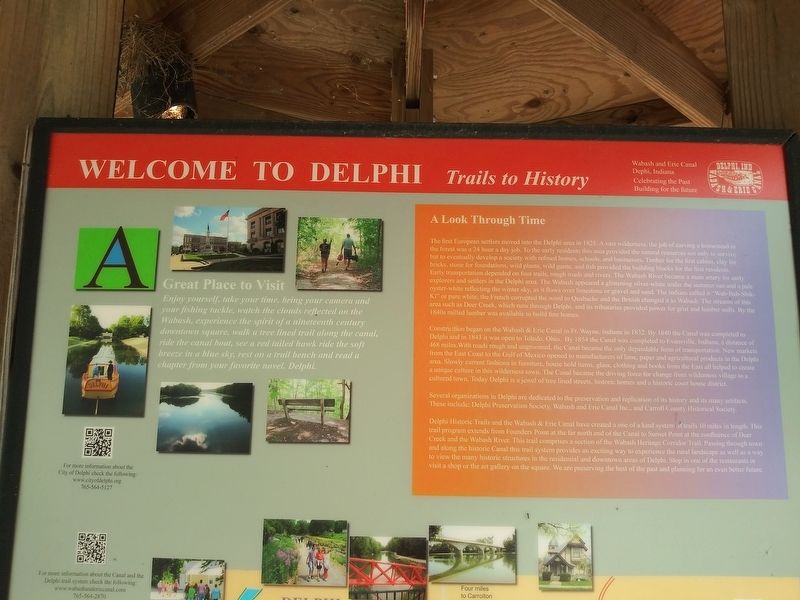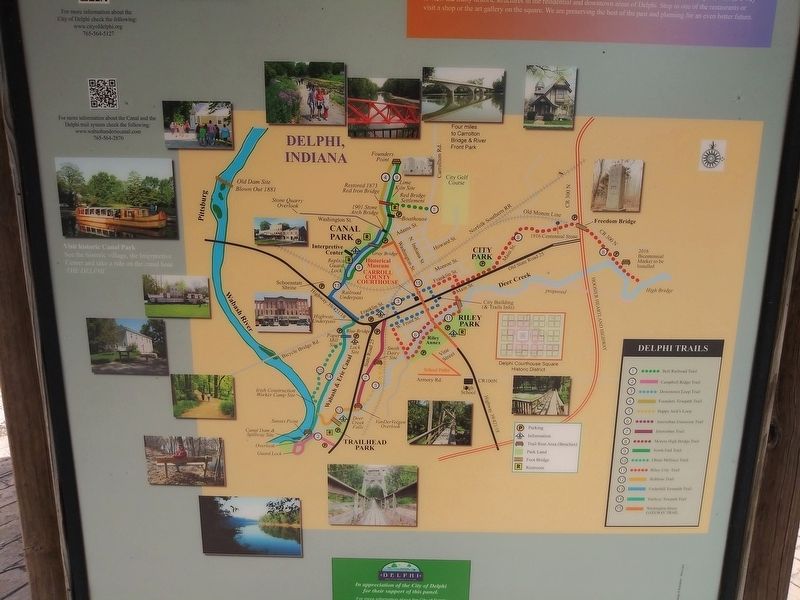Welcome To Delphi
Trails to History
— Wabash & Erie Canal Park Village —
Great Place to Visit
Enjoy yourself, take your time, bring your camera and your fishing tackle, watch the clouds reflected on the Wabash, experience the spirit of a nineteenth century downtown square, walk a tree lined trail along the canal, ride the canal boat, see a red tailed hawk ride the soft breeze in a blue sky, rest on a trail bench and read a chapter from your favorite novel. Delphi.
A Look Through Time
The first European settlers moved into the Delphi area in 1825. A vast wilderness, the job of carving a homestead in
the forest was a 24 hour a day job. To the early residents this area provided the natural resources not only to survive
but to eventually develop a society with refined homes, schools, and businesses. Timber for the first cabins, clay for
bricks, stone for foundations, wild plants, wild game, and fish provided the building blocks for the first residents.
Early transportation depended on foot trails, rough roads and rivers. The Wabash River became a main artery for early
explorers and settlers in the Delphi area. The Wabash appeared a glistening silver-white under the summer sun and a pale
oyster-white reflecting the winter sky, as it flows over limestone or gravel and sand. The indians called it "Wab-Bab-Shik-
Ki” or pure white; the French corrupted the word
Construction began on the Wabash & Erie Canal in Ft. Wayne, Indiana in 1832. By 1840 the Canal was completed to Delphi and in 1843 it was open to Toledo, Ohio. By 1854 the Canal was completed to Evansville, Indiana, a distance of 468 miles.With roads rough and ungroomed, the Canal became the only dependable form of transportation. New markets from the East Coast to the Gulf of Mexico opened to manufacturers of lime, paper and agricultural products in the Delphi area. Slowly current fashions in furniture, house hold items, glass, clothing and books from the East all helped to create a unique culture in this wilderness town. The Canal became the driving force for change from wilderness village to a cultured town. Today Delphi is a jewel of tree lined streets, historic homes and a historic court house district.
Several organizations in Delphi are dedicated to the preservation and replication of its history and its many artifacts. These include: Delphi Preservation Society, Wabash and Erie Canal Inc., and Carroll County Historical Society.
Delphi Historic Trails and the Wabash & Erie Canal have created a one of a
kind system of trails 10 miles in length. This trail program extends from Founders Point at the far north end of the Canal to Sunset Point at the confluence of Deer Creek and the Wabash River. This trail comprises a section of the Wabash Heritage Corridor Trail. Passing through town and along the historic Canal this trail system provides an exciting way to experience the rural landscape as well as a way to view the many historic structures in the residential and downtown areas of Delphi. Stop in one of the restaurants or visit a shop or the art gallery on the square. We are preserving the best of the past and planning for an even better future.
Visit historic Canal Park
See the historic village, the Interpretive
Center and take a ride on the canal boat The Delphi.
Erected by City Of Delphi.
Topics and series. This historical marker is listed in these topic lists: Bridges & Viaducts • Waterways & Vessels. In addition, it is included in the Wabash & Erie Canal series list. A significant historical year for this entry is 1825.
Location. 40° 35.483′ N, 86° 40.833′ W. Marker is in Delphi, Indiana, in Carroll County. Marker can be reached from the intersection of West North Washington Street and North Charles Street, on the right when traveling east. On the Grounds
Other nearby markers. At least 8 other markers are within walking distance of this marker. River Travel (here, next to this marker); Welcome To Canal Park (here, next to this marker); Wabash & Erie Canal (here, next to this marker); Lewis Thomas Jones (a few steps from this marker); Constructing the Wabash & Erie Canal (a few steps from this marker); An Herb Garden (within shouting distance of this marker); Blacksmithing (within shouting distance of this marker); Native Plants of the Canal (within shouting distance of this marker). Touch for a list and map of all markers in Delphi.
Credits. This page was last revised on December 25, 2020. It was originally submitted on December 25, 2020, by Craig Doda of Napoleon, Ohio. This page has been viewed 108 times since then and 8 times this year. Photos: 1, 2. submitted on December 25, 2020, by Craig Doda of Napoleon, Ohio. • Devry Becker Jones was the editor who published this page.

